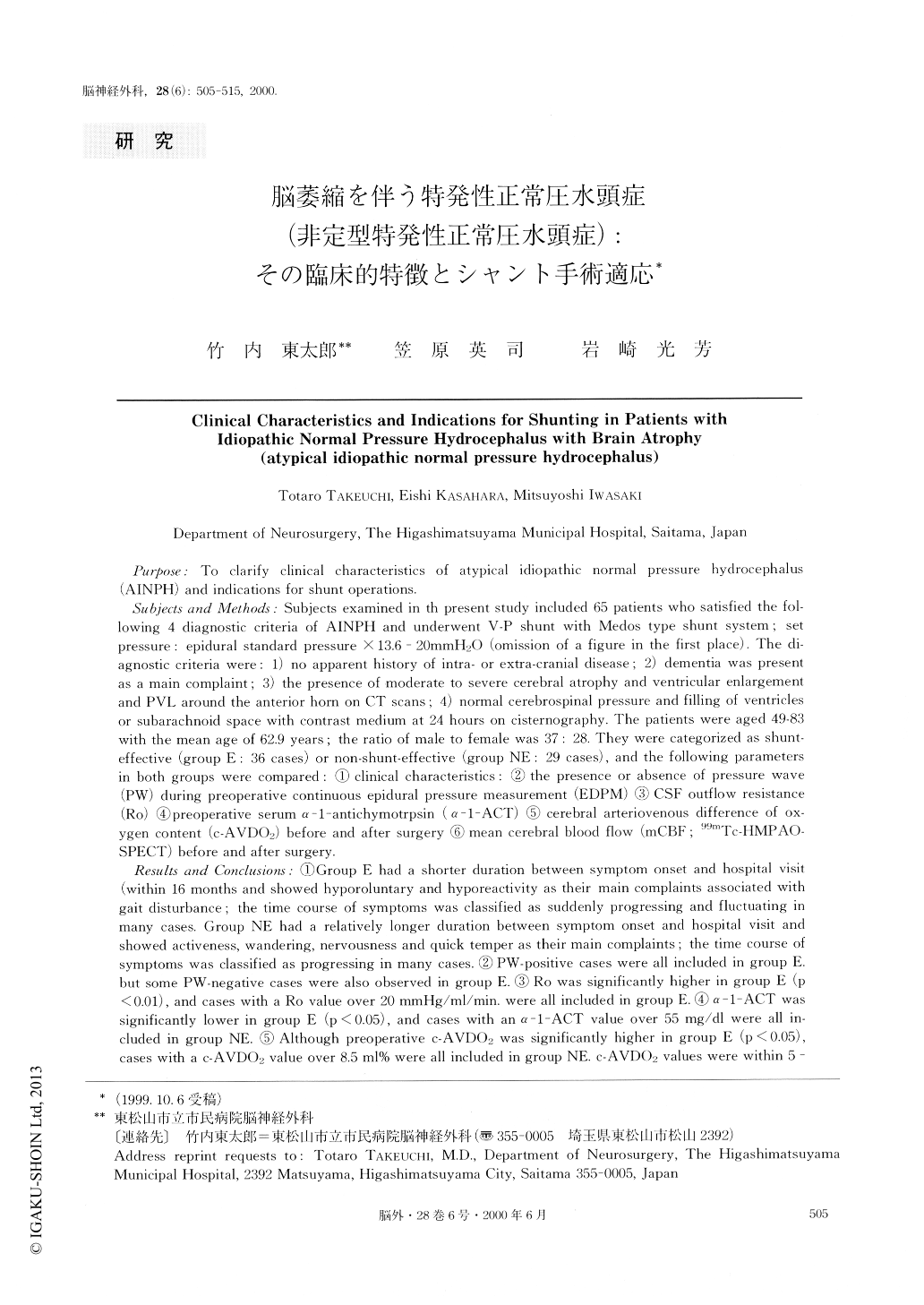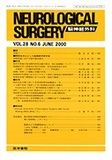Japanese
English
- 有料閲覧
- Abstract 文献概要
- 1ページ目 Look Inside
Ⅰ.はじめに
著者らは本来の特発性正常圧水頭症(idiopathicnormal pressure hydrocephalus:INPH)の中で基礎病態としてすでに脳萎縮を伴っている一群に注目し,これを非定型特発性正常圧水頭症(atypicalINPH:AINPH)と定義して検討してきた40,41).今回はAINPHの概念と臨床的特徴ならびにシャント手術適応について報告する.
Purpose: To clarify clinical characteristics of atypical idiopathic normal pressure hydrocephalus (AINPH) and indications for shunt operations.
Subjects and Methods: Subjects examined in th present study included 65 patients who satisfied the fol-lowing 4 diagnostic criteria of AINPH and underwent V-P shunt with Medos type shunt system; set pressure: epidural standard pressure×13.6-20mmH2O (omission of a figure in the first place). The di-agnostic criteria were: 1) no apparent history of intra-or extra-cranial disease; 2) dementia was present as a main complaint; 3) the presence of moderate to severe cerebral atrophy and ventricular enlargement and PVL around the anterior horn on CT scans; 4) normal cerebrospinal pressure and filling of ventricles or subarachnoid space with contrast medium at 24 hours on cisternography. The patients were aged 49-83 with the mean age of 62.9 years; the ratio of male to female was 37: 28. They were categorized as shunt-effective (group E: 36 cases) or non-shunt-effective (group NE: 29 cases), and the following parameters in both groups were compared: ① clinical characteristics: ② the presence or absence of pressure wave (PW) during preoperative continuous epidural pressure measurement (EDPM) ③ CSF outflow resistance (Ro) ④preoperative serum α-1-antichymotrpsin (α-1-ACT) ⑤ cerebral arteriovenous difference of ox-ygen content (c-AVDO2) before and after surgery ⑥ mean cerebral blood flow (mCBF; 99mTc-HMPAO-SPECT) before and after surgery.
Results and Conclusions: ① Group E had a shorter duration between symptom onset and hospital visit (within 16 months and showed hyporoluntary and hyporeactivity as their main complaints associated with gait disturbance; the time course of symptoms was classified as suddenly progressing and fluctuating in many cases. Group NE had a relatively longer duration between symptom onset and hospital visit and showed activeness, wandering, nervousness and quick temper as their main complaints; the time course of symptoms was classified as progressing in many cases. ② PW-positive cases were all included in group E. but some PW-negative cases were also observed in group E. ③ Ro was significantly higher in group E (p <0.01), and cases with a Ro value over 20mmHg/ml/min. were all included in group E. ④ α-1-ACT was significantly lower in group E (p<0.05), and cases with an α-1-ACT value over 55mg/dl were all in-cluded in group NE. ⑤ Although preoperative c-AVDO2 was significantly higher in group E (p<0.05), cases with a c-AVDO2 value over 8.5ml% were all included in group NE. c-AVDO2 values were within 5-8.5ml% in all cases of group E. ⑥ mCBF significantly increased after surgery in group E (p<0.001). ⑦ It was confirmed that cerebral atrophy in group E on AINPH is caused by a cerebral circulation disturbance defined as a cerebral blood flow of penumbra or more due to cerebral arteriosclerosis, etc. ⑧ A flowchart of indications for shunt surgery for AINPH was prepared based on the results of the present study.

Copyright © 2000, Igaku-Shoin Ltd. All rights reserved.


